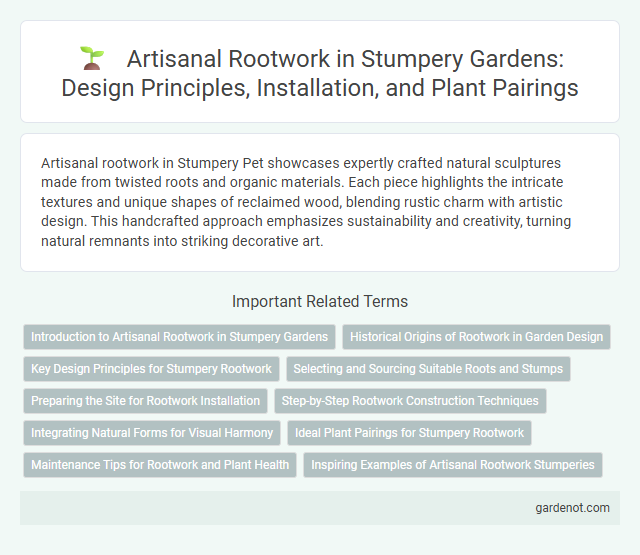Artisanal rootwork in Stumpery Pet showcases expertly crafted natural sculptures made from twisted roots and organic materials. Each piece highlights the intricate textures and unique shapes of reclaimed wood, blending rustic charm with artistic design. This handcrafted approach emphasizes sustainability and creativity, turning natural remnants into striking decorative art.
Introduction to Artisanal Rootwork in Stumpery Gardens
Artisanal rootwork in stumpery gardens showcases the intricate craftsmanship of arranging natural tree roots and driftwood into sculptural displays that mimic woodland environments. This technique emphasizes the unique textures, organic shapes, and natural weathering of each root, creating visually compelling, tactile focal points within garden landscapes. Rootwork enhances biodiversity by providing habitats for mosses, lichens, and insects, enriching the ecological value of stumpery designs.
Historical Origins of Rootwork in Garden Design
Artisanal rootwork in garden design traces its historical origins to 19th-century Victorian England, where stumperies emerged as a unique form of garden art utilizing tree roots, stumps, and driftwood to create intricate natural sculptures. These rootworks were often designed to mimic gothic architecture and fostered a deeper appreciation for organic textures and forms within landscaped gardens. The tradition reflects a fusion of horticultural creativity and craftsmanship, highlighting the enduring cultural value of reclaimed wood aesthetics in garden artistry.
Key Design Principles for Stumpery Rootwork
Artisanal rootwork in stumpery emphasizes natural forms, preserving the intricate textures and shapes of roots to showcase their organic beauty. Key design principles include selecting diverse root types for contrasting patterns, arranging pieces to create visual flow and harmony, and integrating moss or ferns to enhance the naturalistic aesthetic. Balancing complexity and simplicity ensures the rootwork remains a focal point while blending seamlessly into garden surroundings.
Selecting and Sourcing Suitable Roots and Stumps
Selecting and sourcing suitable roots and stumps for artisanal stumpery involves identifying naturally gnarled, weathered wood with intricate textures that enhance visual appeal. Sustainable harvesting from fallen or reclaimed trees ensures ecological responsibility while preserving unique shapes ideal for showcasing mosses, ferns, and shade-loving plants. Attention to wood type, such as oak, cedar, or driftwood, influences durability and authenticity in creating striking, naturalistic garden sculptures.
Preparing the Site for Rootwork Installation
Preparing the site for artisanal rootwork involves clearing debris and ensuring stable, well-drained soil to support the intricate placement of roots. Moistening the ground enhances root flexibility for shaping while preventing future shifting or settling. Proper site preparation creates a durable foundation that highlights the natural textures and forms of the rootwork installation.
Step-by-Step Rootwork Construction Techniques
Artisanal rootwork involves carefully selecting twisted, gnarled tree roots to create intricate natural sculptures that enhance a stumpery's rustic charm. Step-by-step construction begins with cleaning and stabilizing the roots, followed by designing a balanced composition that highlights organic forms and textures. Techniques include securely anchoring roots with hidden supports and integrating moss or ferns to enrich the visual complexity and authenticity of the rootwork display.
Integrating Natural Forms for Visual Harmony
Artisanal rootwork transforms gnarled roots, driftwood, and branches into intricate sculptural forms that emphasize the natural beauty and unique textures of the wood. Skillful integration of natural forms fosters visual harmony by highlighting organic shapes, flowing lines, and subtle contrasts that mirror woodland aesthetics. This meticulous approach enhances both the tactile and visual experience, creating artworks that celebrate the raw elegance of nature's architecture.
Ideal Plant Pairings for Stumpery Rootwork
Ideal plant pairings for artisanal rootwork in stumpery involve combining ferns like Dryopteris and Polypodium with shade-loving perennials such as hostas and hellebores to create a textured, layered effect. Mosses and lichens enhance the naturalistic aesthetic by covering exposed wood and rooting areas, contributing moisture retention and visual softness. Incorporating small woodland bulbs like scilla and snowdrops adds seasonal color contrasts while thriving in the stumpery's shaded, humus-rich environment.
Maintenance Tips for Rootwork and Plant Health
Regular inspection of artisanal rootwork helps identify early signs of decay or pest infestation, ensuring longevity and aesthetic appeal. Maintaining optimal moisture levels and using organic mulches can enhance plant health and support root vitality. Pruning dead or damaged roots promotes airflow and reduces disease risk, contributing to the overall resilience of stumpery installations.
Inspiring Examples of Artisanal Rootwork Stumperies
Artisanal rootwork stumperies showcase intricate craftsmanship by incorporating natural tree roots and driftwood into artistic garden structures. These inspiring examples highlight the fusion of rustic textures with organic forms, creating unique focal points that enhance woodland or shaded garden spaces. Master artisans skillfully manipulate gnarled roots to construct benches, sculptures, and natural trellises, emphasizing sustainable design and ecological harmony.
Artisanal rootwork Infographic

 gardenot.com
gardenot.com